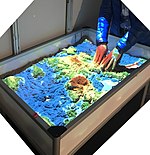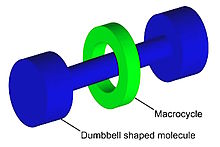
Computing is any goal-oriented activity requiring, benefiting from, or creating computing machinery. It includes the study and experimentation of algorithmic processes, and the development of both hardware and software. Computing has scientific, engineering, mathematical, technological, and social aspects. Major computing disciplines include computer engineering, computer science, cybersecurity, data science, information systems, information technology, and software engineering.

A quantum computer is a computer that takes advantage of quantum mechanical phenomena. On small scales, physical matter exhibits properties of both particles and waves, and quantum computing leverages this behavior, specifically quantum superposition and entanglement, using specialized hardware that supports the preparation and manipulation of quantum states.
Spintronics, also known as spin electronics, is the study of the intrinsic spin of the electron and its associated magnetic moment, in addition to its fundamental electronic charge, in solid-state devices. The field of spintronics concerns spin-charge coupling in metallic systems; the analogous effects in insulators fall into the field of multiferroics.
Hypercomputation or super-Turing computation is a set of hypothetical models of computation that can provide outputs that are not Turing-computable. For example, a machine that could solve the halting problem would be a hypercomputer; so too would one that could correctly evaluate every statement in Peano arithmetic.
Neuromorphic computing is an approach to computing that is inspired by the structure and function of the human brain. A neuromorphic computer/chip is any device that uses physical artificial neurons to do computations. In recent times, the term neuromorphic has been used to describe analog, digital, mixed-mode analog/digital VLSI, and software systems that implement models of neural systems. The implementation of neuromorphic computing on the hardware level can be realized by oxide-based memristors, spintronic memories, threshold switches, transistors, among others. Training software-based neuromorphic systems of spiking neural networks can be achieved using error backpropagation, e.g., using Python based frameworks such as snnTorch, or using canonical learning rules from the biological learning literature, e.g., using BindsNet.
Quantum programming is the process of designing or assembling sequences of instructions, called quantum circuits, using gates, switches, and operators to manipulate a quantum system for a desired outcome or results of a given experiment. Quantum circuit algorithms can be implemented on integrated circuits, conducted with instrumentation, or written in a programming language for use with a quantum computer or a quantum processor.
The limits of computation are governed by a number of different factors. In particular, there are several physical and practical limits to the amount of computation or data storage that can be performed with a given amount of mass, volume, or energy.
Optical computing or photonic computing uses light waves produced by lasers or incoherent sources for data processing, data storage or data communication for computing. For decades, photons have shown promise to enable a higher bandwidth than the electrons used in conventional computers.

Quantum neural networks are computational neural network models which are based on the principles of quantum mechanics. The first ideas on quantum neural computation were published independently in 1995 by Subhash Kak and Ron Chrisley, engaging with the theory of quantum mind, which posits that quantum effects play a role in cognitive function. However, typical research in quantum neural networks involves combining classical artificial neural network models with the advantages of quantum information in order to develop more efficient algorithms. One important motivation for these investigations is the difficulty to train classical neural networks, especially in big data applications. The hope is that features of quantum computing such as quantum parallelism or the effects of interference and entanglement can be used as resources. Since the technological implementation of a quantum computer is still in a premature stage, such quantum neural network models are mostly theoretical proposals that await their full implementation in physical experiments.
A quantum Turing machine (QTM) or universal quantum computer is an abstract machine used to model the effects of a quantum computer. It provides a simple model that captures all of the power of quantum computation—that is, any quantum algorithm can be expressed formally as a particular quantum Turing machine. However, the computationally equivalent quantum circuit is a more common model.

D-Wave Quantum Systems Inc. is a Canadian quantum computing company, based in Burnaby, British Columbia. D-Wave claims to be the world's first company to sell computers that exploit quantum effects in their operation. D-Wave's early customers include Lockheed Martin, University of Southern California, Google/NASA and Los Alamos National Lab.
Reservoir computing is a framework for computation derived from recurrent neural network theory that maps input signals into higher dimensional computational spaces through the dynamics of a fixed, non-linear system called a reservoir. After the input signal is fed into the reservoir, which is treated as a "black box," a simple readout mechanism is trained to read the state of the reservoir and map it to the desired output. The first key benefit of this framework is that training is performed only at the readout stage, as the reservoir dynamics are fixed. The second is that the computational power of naturally available systems, both classical and quantum mechanical, can be used to reduce the effective computational cost.
Adiabatic quantum computation (AQC) is a form of quantum computing which relies on the adiabatic theorem to perform calculations and is closely related to quantum annealing.
A physical neural network is a type of artificial neural network in which an electrically adjustable material is used to emulate the function of a neural synapse or a higher-order (dendritic) neuron model. "Physical" neural network is used to emphasize the reliance on physical hardware used to emulate neurons as opposed to software-based approaches. More generally the term is applicable to other artificial neural networks in which a memristor or other electrically adjustable resistance material is used to emulate a neural synapse.

Quantum machine learning is the integration of quantum algorithms within machine learning programs.
The DiVincenzo criteria are conditions necessary for constructing a quantum computer, conditions proposed in 2000 by the theoretical physicist David P. DiVincenzo, as being those necessary to construct such a computer—a computer first proposed by mathematician Yuri Manin, in 1980, and physicist Richard Feynman, in 1982—as a means to efficiently simulate quantum systems, such as in solving the quantum many-body problem.
In quantum computing, quantum supremacy or quantum advantage is the goal of demonstrating that a programmable quantum computer can solve a problem that no classical computer can solve in any feasible amount of time, irrespective of the usefulness of the problem. The term was coined by John Preskill in 2012, but the concept dates to Yuri Manin's 1980 and Richard Feynman's 1981 proposals of quantum computing.
In quantum computing, a qubit is a unit of information analogous to a bit in classical computing, but it is affected by quantum mechanical properties such as superposition and entanglement which allow qubits to be in some ways more powerful than classical bits for some tasks. Qubits are used in quantum circuits and quantum algorithms composed of quantum logic gates to solve computational problems, where they are used for input/output and intermediate computations.
Applying classical methods of machine learning to the study of quantum systems is the focus of an emergent area of physics research. A basic example of this is quantum state tomography, where a quantum state is learned from measurement. Other examples include learning Hamiltonians, learning quantum phase transitions, and automatically generating new quantum experiments. Classical machine learning is effective at processing large amounts of experimental or calculated data in order to characterize an unknown quantum system, making its application useful in contexts including quantum information theory, quantum technologies development, and computational materials design. In this context, it can be used for example as a tool to interpolate pre-calculated interatomic potentials or directly solving the Schrödinger equation with a variational method.
This glossary of quantum computing is a list of definitions of terms and concepts used in quantum computing, its sub-disciplines, and related fields.














